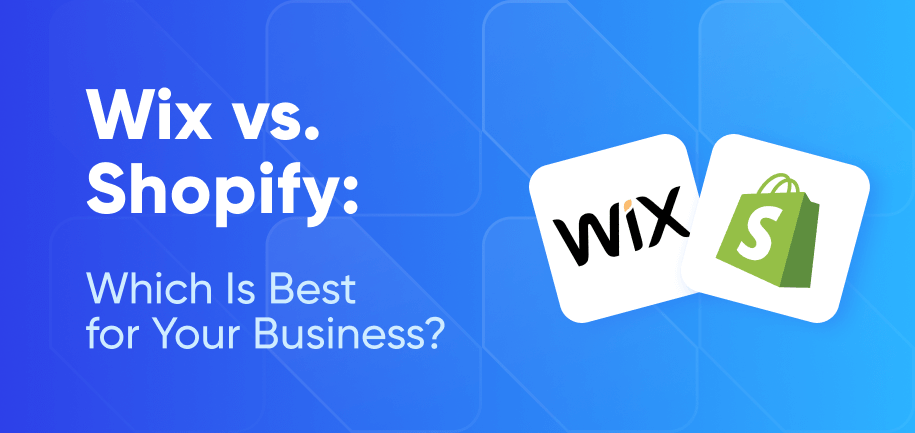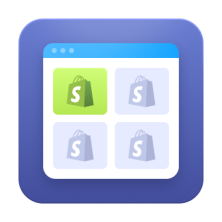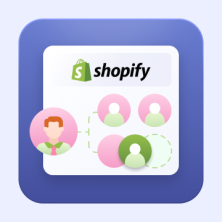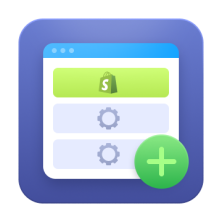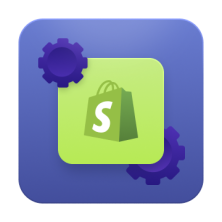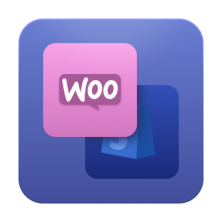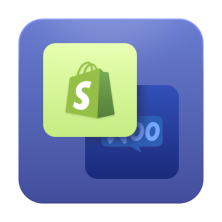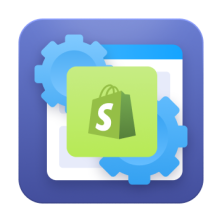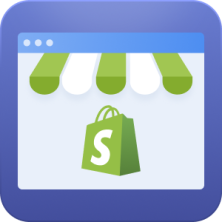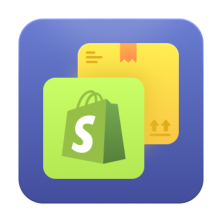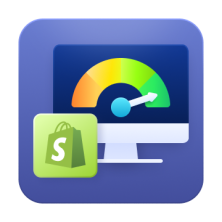The Shopify vs Etsy dilemma is a very common one. Both e-commerce solutions empower sellers to reach shoppers worldwide with their product offerings and you'll be in good hands with either. After all, these two giant sales venues aim to help you build a thriving e-business.
Despite the shared goal, these solutions are very different. While Shopify is a user-friendly platform for developing your store from scratch, Etsy is an e-commerce marketplace similar to eBay, catering to merchants with little to no technical skills.
So, how does selling on Shopify vs Etsy compare? Let’s see the main differences between these two options in the areas of pricing, website design tools, marketing and sales features, shipping benefits, security systems, and others.
Etsy or Shopify? Key Difference
Before you start setting up your online selling operation through one of these two (or more – see below) e-commerce systems, you should know the major differences between what they are intended to be used for and what they offer to help you succeed.
Read More: Shopify vs. Magento vs. WooCommerce
Shopify enables users to build their own store space and develop their brand. It’s a full-scope e-commerce platform. You’ll have access to industry-leading site design tools, including design themes, landing page templates, apps, plugins, and other e-commerce development features to help you build your online store, set up your sales operations, and grow your business from the ground up.
Etsy is an online marketplace that allows individual sellers to list, present, and sell their items directly to buyers, competing with other sellers on the same platform. This means sellers benefit from Etsy's built-in customer base, search functionality, and marketplace features, but have less control over the branding and customization of their individual shop spaces.
In a nutshell, while Shopify provides users with the tools to create their own standalone online store, Etsy hosts all sellers within a single platform.
Selling on Shopify vs. Etsy: Comparison Table and Details
We’ve prepared a side-by-side Shopify Etsy comparison in two tables. Part 1 features basic information such as subscription prices, fees, payment options, and more.
Feature | Etsy | Shopify |
|---|---|---|
Target Audience | Artists, crafters, and sellers of privately manufactured items | Any business, ranging from startups to large enterprises |
Store Ownership | Etsy owns the marketplace, sellers own the listings | Full store ownership, including data and customer information |
Custom Domain | Not available | Available (custom domain name registration) |
Mobile App | Etsy Seller app for managing listings and orders | Shopify app for managing your store on the go |
Subscription Prices | Free option or $10 monthly option | $29, $79, or $299 monthly rate paid annually. Or, $39, $89, or $399 paid monthly |
Additional Costs | $0.20 listing fee | 2.9% + $0.30 online fee |
Customization Options | Limited customization of the shop's appearance | Extensive customization options with templates, apps, plugins |
Payment Options | Etsy Payments (varies by country) | Multiple payment gateways, including Shopify Payments, PayPal, etc. |
POS (Point of Sale) | Not available | Shopify POS available for in-person sales |
International Selling | Supports international shipping, multiple languages, and currencies | Comprehensive international selling options with multiple languages, currencies, and tax settings |
Shipping Discounts | Up to 30% | Up to 77% on Basic plan. Up to 88% on more advanced plans |
Let’s shed more light on the more intricate points that may interest you as a merchant.
Shopify Fees vs. Etsy Fees
Understanding the fee structures on Shopify and Etsy is crucial for evaluating the cost of doing business on each platform. Here’s a detailed comparison:
Etsy Fees:
- Listing Fees – $0.20 per item listed, renewed every four months or when the item sells.
- Transaction Fees – 6.5% of the total sale price, including shipping.
- Payment Processing Fees – 3% + $0.25 per transaction in the U.S. (varies by country).
- Offsite Ads Fee – 3% if you make under $10,000 in sales in the past 12 months; 12% if you make over $10,000.
- Subscription – Etsy Plus at $10 per month, which provides additional customization options and credits for listings and ads.
Shopify Fees:
- Subscription Fees:
- Basic Plan – $29/month (annually) or $39/month (monthly).
- Shopify Plan – $79/month (annually) or $89/month (monthly).
- Advanced Plan – $299/month (annually) or $399/month (monthly).
- Transaction Fees:
- Online Credit Card Rates – 2.9% + $0.30 (Basic), 2.6% + $0.30 (Shopify), 2.4% + $0.30 (Advanced).
- In-Person Rates – 2.7% (Basic), 2.5% (Shopify), 2.4% (Advanced).
- Additional Fees: If not using Shopify Payments, an additional fee of 2% (Basic), 1% (Shopify), or 0.5% (Advanced) per transaction applies for external payment gateways.
To sum up, Etsy’s fee structure is simpler but can add up quickly with multiple listings and high transaction volumes, especially when factoring in offsite ad fees. Shopify’s fee structure includes a higher upfront cost with its subscription plans but offers more comprehensive features and lower transaction fees with Shopify Payments.
The choice between the two depends on your business model, sales volume, and preference for platform features versus cost predictability.
Website Setup
The setup process for Etsy is short and simple. As a new user, you will be led through a brief series of steps, like naming your brand, uploading the details for each item you want to sell, and explaining the shipping and returns information. The integrations you can set up for more convenient product management is, however, limited.
Shopify, on the other hand, is an e-commerce self-help or pro-help site builder: you will be guided through the complete guide for setting up your store site but you’ll need expert help to leverage the customization and optimization possibilities in full. The platform enables smooth integrations with countless PIMs, ERPs, and other business platforms to create formidable online businesses.
Web Design and Customization
Etsy does not offer options beyond its standard generic frameworks for product presentation. It is not a space meant to use templates, apps, or plugins build to customize sales spaces. As a seller, you only have minimal opportunity to improve your items’ presentation appeal to shoppers. There are, however, more aesthetically competitive Pattern designs available for a cost of $15 per month.
Meanwhile, Shopify features quite a spectacular selection of polished professional e-store design templates – both free and paid. It also offers dozens of feature-rich apps and extensions that can help you enhance your store’s functionality, further personalize its aesthetic and match your brand book.
Payment and Data Security
Etsy holds an SSL certificate, ensuring that all customer payment transactions are securely completed on a secure server. This means that sensitive payment information is encrypted and protected during transmission. However, beyond this basic level of security, Etsy's additional security measures are less transparent compared to other e-commerce platforms. Etsy focuses on protecting transactions and user data, but detailed information about specific security protocols and measures is not as readily available.
Shopify also holds SSL certificates to encrypt data during transactions, ensuring that all communications between the store and customers are secure. But what’s more, Shopify employs intensive security system monitoring (including secure login, two-step authentication, and fraud detection systems) and compliance with PCI DSS, which further enhances the protection of sensitive information.
Payment Options
Etsy Payments allows sellers to accept various payment methods, including credit/debit cards, PayPal, and Apple Pay, depending on the seller’s location. While convenient, the options can be somewhat limited by regional availability but Etsy is constantly expanding the reach.
Shopify, however, supports a wide range of payment gateways globally. In addition to Shopify Payments, which simplifies the payment process and reduces transaction fees, Shopify supports PayPal, Stripe, and many other third-party payment processors. This flexibility allows merchants to choose the best options for their business and customers.
POS (Point of Sale)
Shopify POS is a robust solution for merchants who sell both online and in physical locations. It allows seamless integration between online and offline sales, managing inventory, and processing payments in person. Shopify POS supports various payment methods and provides hardware options for a complete retail setup. This makes it an excellent choice for businesses looking to unify their sales channels.
Etsy does not offer a dedicated POS system. Sellers who participate in craft fairs or pop-up shops need to use third-party solutions to manage in-person sales, which can result in fragmented inventory management and inconsistent sales tracking.
Read More: The True Costs of a Point of Sale Solution
In Part 2 of the Shopify Etsy comparison table, let’s look at the additional features, scalability potential, and integrations.
Feature | Etsy | Shopify |
|---|---|---|
Customer Base | Built-in traffic from Etsy’s marketplace | Traffic needs to be generated by the store owner |
Return Policies | Seller-defined return policies, subject to Etsy guidelines | Store owner defines return policies |
Marketing and SEO Tools | Basic marketing tools provided by Etsy | Advanced marketing tools including SEO, email marketing, and more |
Blogging Capabilities | Not available | Built-in blogging platform for content marketing |
Analytics | Basic analytics provided by Etsy | Comprehensive analytics and reporting tools |
Scalability | Limited scalability options | Highly scalable with various plans and features |
Customer Support | Standard customer support | 24/7 customer support via phone, chat, and email |
Abandoned Cart Recovery | Not available | Available on higher-tier plans |
Third-Party Integrations | Limited integrations with external services | Extensive third-party app marketplace |
Dropshipping | Not directly supported | Supported through apps like Oberlo |
Wholesale Options | Limited options | Available through Shopify apps |
International Selling
Etsy supports international selling by allowing sellers to list items in multiple languages and accept various currencies. It automatically translates listings and calculates currency conversions for buyers, which simplifies the process for both sellers and international customers. However, tax settings and compliance with international shipping regulations largely depend on the seller.
Shopify offers comprehensive tools for international selling. Sellers can create multilingual stores, accept payments in multiple currencies, and configure regional tax settings. Shopify also guides international shipping and compliance, making it easier for merchants to expand their reach globally.
Shipping Discounts
Etsy offers shipping discounts of up to 30%, but these discounts depend on specific conditions such as shipping volume and carrier agreements. Sellers benefit from discounted rates through Etsy's partnerships with shipping carriers, which can help reduce overall shipping costs for their buyers.
On the other hand, Shopify provides more substantial shipping discounts, particularly for users on higher-tier plans. Basic plan users can get up to 77% off, while those on advanced plans can save up to 88%. Shopify partners with major carriers like USPS, UPS, and DHL to offer these discounts, which can be especially beneficial for high-volume sellers.
Customer Support
Etsy's standard customer support includes a Help Center with articles and resources, as well as email support and community forums. The company does list phone and live chat support options but offers it only during specific hours, which might be sufficient for many sellers but can be restrictive in urgent situations.
Shopify provides 24/7 customer support via phone, chat, and email. This means that regardless of the time or issue, Shopify users can get immediate assistance. This level of support can be crucial for resolving technical issues quickly and ensuring the smooth operation of your online store.
Abandoned Cart Recovery
Abandoned cart recovery is a powerful feature that Shopify offers on its higher-tier plans. It allows merchants to automatically send emails to customers who add items to their cart but do not complete the purchase. These emails can include discounts or reminders, which help to recover lost sales and boost conversion rates. This feature is particularly useful for increasing revenue without additional marketing spend.
Etsy does not offer an abandoned cart recovery feature. Sellers need to rely on other cart recovery methods, such as manual follow-ups or external email marketing services, to reach out to potential customers who did not complete their purchases.
Third-Party Integrations
Etsy offers limited integrations with external services, primarily focusing on tools that enhance listing, shipping, and marketing functions. While sufficient for many small businesses, the range of integrations might not meet the needs of more complex operations.
Shopify boasts an extensive app marketplace with thousands of third-party integrations. These apps cover a broad spectrum of functionalities, including marketing, sales, customer service, and inventory management. This vast choice of integrations (Shopify x Instagram, Facebook, TikTok, etc.) allows businesses to customize their store and scale their operations.
Dropshipping
Dropshipping is not directly supported by Etsy. Sellers on Etsy typically create and ship their products themselves, focusing on handmade or unique items. Those interested in dropshipping would need to find external platforms or methods to integrate this business model with their Etsy shop, which can be complex and cumbersome.
Shopify, conversely, supports dropshipping through various dropshipping apps. These apps allow merchants to add products from suppliers directly to their stores, without holding inventory. This makes it easier for Shopify users to start a business with minimal upfront investment and manage their operations efficiently.
Read More: How to Launch Dropshipping with Shopify
Wholesale Options
Etsy offers limited options for wholesale transactions. While sellers can create bulk listings and offer discounts for larger orders, the platform does not provide specialized tools for managing wholesale relationships or pricing.
Shopify, on the other hand, offers numerous apps and features to support wholesale businesses. Merchants can create password-protected wholesale sections, offer tiered pricing, and manage bulk orders effectively. These capabilities make Shopify a more versatile platform for businesses looking to cater to both retail and wholesale customers.
Is Shopify Better than Etsy – or Vice Versa?
The answer to this question is another question: What kinds of online sales businesses are best served by Shopify vs Etsy? All the comparative platform features aside, looking closely at this distinction is the shortcut to becoming clear on which platform is likely to work best for your needs.
Shopify may be your best choice if one of these scenarios fits your needs:
- You have a growing business and are scaling your inventory operations. Shopify features cutting-edge digital tools and processes for efficient inventory management.
- You need systemic marketing features designed to help you scale your online sales. For example, you want multi-channel selling options, CMS integration, email marketing systems in place, etc.
- You want a wide selection of site design templates and other features to help you achieve your creative vision for your store design.
- You need to be able to offer your customers a wide range of payment methods to make buying your products maximally accessible to your particular market.
Etsy may be your best choice if one of these scenarios fits your needs:
- You sell crafts, other handmade items, or vintage goods. These are Etsy’s primary product classes.
- You have a small store with a very limited inventory.
- You want to access a broad base of shoppers very quickly, ideally without spending resources on marketing.
How to Choose the Best E-commerce Platform
A quick skim through just the pricing segments of the Shopify Etsy comparison table above may appear, at first glance, to tell you all you need to know. However, determining the best value between any e-commerce business services requires a few more considerations. For example, you should consider:
- Which platform puts your products and/or services in front of the right audience?
- Which presents your offerings to shoppers in a way most conducive to sales success?
- Which facilitates sales in high enough volume at a low enough cost to maximize profits?
Above all, figure out which digital sales platform positions your business most advantageously to make the largest profit over time and build a strong brand on the web.
Shopify vs Etsy: Takeaways
Both e-commerce platforms are proven high performers in delivering what they’re designed to do for online sellers. However, as we’ve discussed, they’re very different in their approaches to achieving that.
Etsy is a bustling digital marketplace fit for small sellers who offer a limited inventory of creative and self-manufactured items. Sellers can upload their product information and immediately access the platform’s huge audience of shoppers. The platform is not set up for sellers to design and run independent stores – instead, they each become a part of a larger sales ecosystem.
Shopify is a better solution for building and scaling a business online. It is an exceptionally robust platform for building your own digital store to look and function however you wish and operate it under the systems you determine are best for you and your customers. Even if you opt to move away from Shopify or close your business at some point, your customer base is not grounded on the platform. It comes with you.
Do you need Shopify? Or will Etsy serve your needs initially? The answer is that it depends on what you really need to accomplish your primary goal for your online business and how much you’re willing to pay for the things you require to get it done.
Frequently Asked Questions
Shopify is the right place to go online if you want to set up a small online sales business. It offers a vast array of easy-to-use options for customizing a digital store space, to create a very polished and appealing shopping environment. It further allows you to sell unlimited products, and it makes selling, payment processing, order fulfillment, and inventory control easy to manage.
No, Etsy is not designed for the purpose of building online stores to operate independently on its platform. The Etsy business model is that of a digital marketplace where many sellers share the sales space, uploading their products for presentation to the platform’s large audience.
In 2017, Shopify acquired Oberlo, one of the world’s most successful dropshipping services. Shopify’s Oberlo dropshipping is among the industry’s best systems for seamless retail sales order fulfillment. What’s more, the Shopify App Marketplace features many other dropshipping apps.












